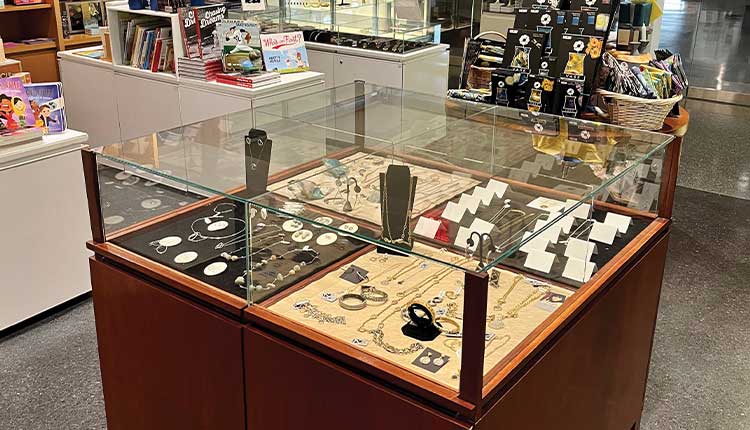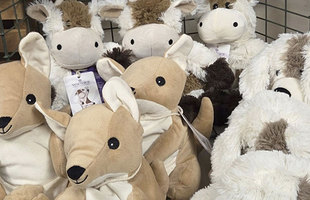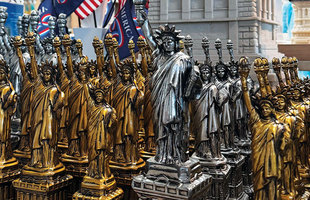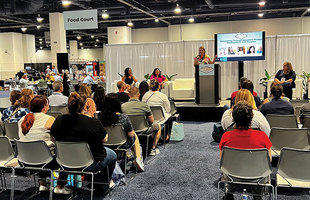A Star of David pendant is an affirming statement of Jewish identity — and a perfect memento from the Weitzman National Museum of American Jewish History in Philadelphia, where classic and modern star pieces are among the museum store’s top sellers.
The 1,800-square-foot museum store has become a destination for Judaica gifts, where Managing Director for Business Operations Kristen Kreider seeks out “more interesting interpretations” of classic Jewish designs.
Kreider says the stars are a favorite among the store’s “symbol jewelry,” a mostly $50 to $80 category that also includes necklaces and bracelets emblazoned with Hebrew phrases and “chai” pendants featuring the Hebrew word for life.
“The symbol jewelry is just kind of a given for the bar or bat mitzvah gift,” Kreider notes. “A nice heavy Star of David or a chai is popular from the grandparents.”
Kreider also sees visible Jewish expression as a growing trend. “The last 20 years, Jewish pride is on display more than it ever was,” she says. A typical customer “may be a 40- or 50-year-old woman who’s never owned a Star of David before, never felt quite comfortable wearing it in public, and now she wants to show her faith through adornment.”
The “ahava” design — a Hebrew version of Robert Indiana’s iconic “Love” motif (ahava means love in Hebrew) is another top seller. The Israel Museum in Jerusalem commissioned the sculpture from Indiana “so it’s a great Philadelphia Jewish tie-in, a natural winner for us,” notes Kreider.
Drawn to nature
At the University of Oregon Museum of Natural and Cultural History (MNCH), shoppers are drawn to nature-themed jewelry. “So when we’re looking for new merchandise, we look for things that reflect the museum — local minerals, mining, Oregon — even if it’s something that doesn’t necessarily say the museum on it,” says Sire Pro, a University of Oregon student who oversees the gift shop as the museum’s Visitor Experience Lead. “I try to order things that go along with our exhibits or the natural history theme.”
For instance, although the museum does not feature dinosaurs, patrons associate the popular dinosaur earrings with exhibitions on fossils and prehistoric relics. Those earrings come from the store’s top-selling jewelry line, a local vendor called Boutique Academia beloved for its science-themed pieces — chemical symbols or fossils carved or engraved into metal or inlaid with rocks and stones.
“We get a lot of archaeologists and other scientists shopping,” explains Pro. “A lot of our staff buys gifts here for their families.”
Finer finds
To find new jewelry, Pro researches online and within the community. She’s discovered vendors at Saturday markets and has long-standing relationships with artisans who mainly sell through the museum store.
“These are handmade, one-of-a-kind pieces that are more high-end,” Pro notes. “They appeal to people who either get a discount in the store or know that their purchase supports the museum and local artists, and that’s where they want to put their money.”
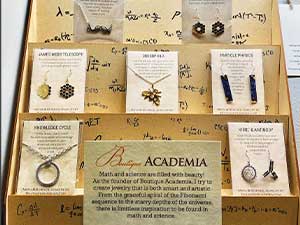
University of Oregon MNCH store dedicates sections to popular brands.
Kreider sources from a variety of vendors, including Etsy and other online marketplaces and local artisan studios. With the New York trade shows, such as NY Now, back in action post-pandemic, she has invested in more expensive jewelry for the store’s other main category, fine designer pieces. These typically run into the hundreds of dollars and sell to the 40s-and-up crowd.
“This season, I really went deep into the higher end,” Kreider says. “If I find a designer that I like and we can negotiate a price, it’s a win.”
She expects the gamble to pay off: Museum shoppers “can justify the expenditure more easily than, for example, if they were at Nordstrom,” Kreider explains. “They’re looking for an opportunity to support the museum, and jewelry is more fun than writing a check.”
Still, Kreider is mindful of having pieces at a variety of price points. Groups of teenage girls will buy $10-$20 bracelets in different colors, with trendy motifs like pomegranates or the evil eye — “symbols that aren’t quite as religious in nature.” Young shoppers favor inexpensive, hand-beaded and woven bracelets marketed as fundraisers for children’s organizations. “And little kids are kind of a captive audience,” observes Kreider. “They shop by price point, not by what they want. They’ll ask, ‘What do you have for $5? $10?’”
Adults are the prime jewelry demographic at MNCH, spending up to $250 for a souvenir bauble. For kids, the store has found a hit in the Native Northwest line of colorful, nature-inspired designs by indigenous artists. The gentle price point, $15 to $25, “is more kid friendly,” Pro explains. “But anybody could wear these designs with hummingbirds or whales. They’ve sold out really, really fast.”
“When I’m buying merchandise for the store, because we’re a state park, it has to have an interpretive message about the fort.” — Christopher Rogowski, Sutter’s Fort Museum Store
Shoppers at the Weitzman store are typically motivated “to express their Judaism, or somebody else’s,” Kreider says — along with the desire for a souvenir that’s more personal than a magnet or a T-shirt. “A necklace may not have our name on it,” she noted, “but it’s still a remembrance of their museum and their trip to Philadelphia.”
Apart from an appealingly curated selection, display is a significant factor in museum jewelry sales for MNCH. The store has found success with displays dispersed throughout, dedicating sections to popular vendors like Native Northwest and Boutique Academia.
“Our consignment artists have their own shelves,” Pro explained. “Then up by the register, we’ve got a display case with some of the fancier stuff that people have to request to look at.”
For the kids – and their parents
At the Sutter’s Fort Museum Store in Sacramento, a central jewelry display attracts shoppers as they browse. Christopher Rogowski, director of retail operations for the 600-square-foot outlet, features inexpensive jewelry pieces that cater to his target audience: children.
Sutter’s Fort is a California state historic park, and its gold rush history ties into the state’s fourth grade curriculum.
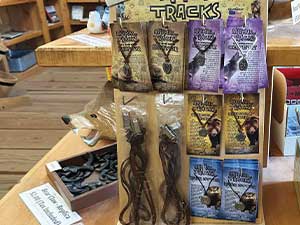
Animal Tracks and other low-priced jewelry is popular with kids visiting Sutter’s Fort.
“We’re hyper focused on nine-year-olds,” Rogowski explains. “70-plus percent of our visitors are under the age of 10. We’ll get visitors from San Francisco, San Diego, Riverside and of course locals from Sacramento County. During the summer, we have tens of thousands of children visiting.”
Sutter’s Fort’s inexpensive entry fee of just $5 also contributes to its popularity with families, according to Rogowski.
For families and school visitors alike, price point is also key to jewelry sales. “We have a lot of items under $20, and even under $10 or $5,” Rogowski says. Popular pieces include rustic, hand-woven bracelets from Guatemala — “we sell a lot of those” — as well as $10 metal necklaces imprinted with the tracks and paw prints of common California animals like beavers, otters and bears.
“I try to order things that go along with our exhibits or the natural history theme.” — Sire Pro, University of Oregon Museum of Natural and Cultural History
Another top seller is a line of $10 to $12 iron rings crafted by a local blacksmith, which ties into Sacramento’s rugged frontier heritage. “When I’m buying merchandise for the store, because we’re a state park, it has to have an interpretive message about the fort,” Rogowski explains. “We’re looking for some kind of connection to the 19th century.”
Travel Town Museum in Los Angeles’ Griffith Park is another California attraction geared toward kids. But Gift Shop Manager Carlos Sosa says it’s the adults who tend to shop the jewelry offerings inside the gift shop, while the kids go for the plush.
From earrings to pocket watches, the store’s jewelry selection is themed around the historical trains of Southern California. “We keep it near the register, in a display table on the countertop,” Sosa says. “Because people are looking for souvenirs, everything is train-related — jewelry and everything else.”
While museum themes and exhibits vary, the reasons that people buy jewelry from their gift shop is largely the same — to remember their visit with a piece that is reminiscent of what they took in while they were there. sgn
